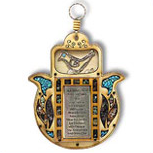Hamsa for Protection
Hamsa
A lucky talisman which shaped like a hand, also known as a protector against the evil eye. Origins in the Arab countries and has no connection to Judaism at all. Hamsa is also called “the Hand of Fatima”, Muhammad’s daughter. Hamsa symbolizes the five commandments of Islam, which are: Walking to Mecca at least once a life, announcement of the Islam in public, giving charity, keeping the Ramadan fasting and prayer three times a day facing Mecca. The Hamsa came to remind every Muslim these five commandments, and promising him an entrance to heaven if he observes the commandments. Originally, Hamsa served as a protection against ghosts and spirits. According to Muslim belief, ghosts and spirits have a tendency to dwell in abandoned places. Therefore, Muslims tend to dip their hand in color (usually blue) and leave their hand print mark on their doors. This sign causes demons to understand, that this house is not abandoned, and people actually live there. This mark prevents ghosts and spirits to enter the house. Hence, the Hamsa’s role parallel to the mezuzah’s roll in Judaism – keeping the house and the people who resides there.
North African Jews brought the Hamsa’s sign with them to Israel, as a protector against the evil eye and bring good luck. This belief is widespread, especially among North African immigrants. Today, you can find the Hamsa in every house, or any key chain. (From the book “Do not know troubles”, by Issac Mizrahi).



